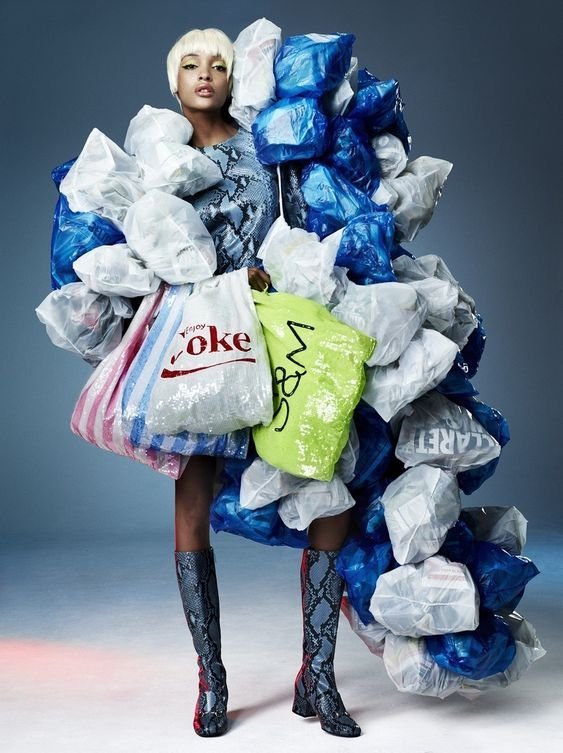The Polyester Paradox - Fake rage or fashion villian?
We’ve all seen the TikToks: “Come shopping with me for natural fibres” and “We’re not buying all that plastic.” The girls are mad — and rightly so. Lately, the girlies have been taking fabrics seriously. We’re checking our labels, learning about natural fibres, and asking what our clothes are actually made from.
But is this genuine progress — or just another micro-trend in the ever-spinning cycle of online outrage? Is it a real shift towards conscious consumerism, or a new marketing tactic for brands to sell us “better” versions of the same thing?
At Sooqlina, we decided to unpack the fundamentals of fashion — starting with one of the most talked-about fabrics out there: polyester.
Back to Basics: What Is Polyester?
Before diving into opinions, let’s break down the facts. Polyester is a synthetic fibre made from oil, which means it’s not biodegradable. Once created, it sticks around — often ending up in landfills, where it can stay for centuries.
It’s also become synonymous with fast fashion, cheap production, and unfair labour practices. So why does it dominate our wardrobes?
Why Everyone Still Uses It
For all the hate it gets, polyester does have its perks — beyond the price tag.
Durable: It lasts ages and keeps costs down. If you love something, you can re-wear it for years.
Low-maintenance: Anti-wrinkle and fuss-free — ideal for abayas or layered outfits when you still want to look polished.
Quick-drying & lightweight: Great for travel, swimwear, or activewear.
Colourfast: Your black abaya stays black, even after multiple washes.
So yes, polyester isn’t the greenest choice — but it’s practical, accessible, and functional. Sometimes, that matters.
I have a pair of synthetic-fibre trousers I’ve worn non-stop for over ten years — they’re stretchy, modest, and still intact. On the other hand, my linen pieces often stay in the wardrobe because they wrinkle easily and feel uncomfortable. That’s the thing about fashion: function often wins over ideals.
Trend or Transformation?
Recently, I posted a wrap-up of autumn collections from modestwear brands, and someone commented: “It’s probably all polyester — show us real materials.”
And it hit me — is this fake rage? The commenter wasn’t talking about a specific piece, nor were they likely to buy anything. Yet this attitude is everywhere: the idea that every brand is evil and polyester is the ultimate villain.
The truth? Polyester is just one of many synthetic fibres, but it gets the worst rep — like the reality TV villain who swears they got a bad edit.
It’s not the root cause of the fashion crisis — it’s a symptom of a much bigger issue. Sustainability is compromised at every stage: production, labour, logistics, even disposal. A brand could use organic cotton and still exploit workers or overproduce.
And lately, we’ve seen the high street go heavy on “natural fabrics” — a suspiciously convenient move. The prices rise, the marketing shifts to old money aesthetics, but the quality? Often the same.
There’s much more to a garment than its material composition. Things like fabric GSM, weaving techniques, and craftsmanship matter too. Yet none of this gets airtime in the current sustainability conversation. Instead, brands like H&M, Mango, and Zara are scrambling to look mid-luxury while barely changing a thing — just dressing the same story in quieter colours and linen-blend tags.
Money Talks
At the core of all this is money. Polyester is cheap, scalable, and profitable, which is why brands love it. It allows them to make high-margin products that mimic “premium” fabrics without the cost.
But it’s also affordable for consumers. Many of the same people who criticise polyester pricing in modestwear brands are still buying dupes from Shein or AliExpress — proof that there’s a strong market for cheap, accessible fashion.
That’s the contradiction of sustainable style: we want ethics, but we also want affordability, trendiness, and convenience.
The Bigger Picture
Even natural fibres aren’t a perfect solution. Yes, cotton, linen, silk, and wool are biodegradable — but only in ideal conditions. In modern landfills, they often don’t decompose properly and can even release methane.
So while the shift towards natural fabrics is encouraging, it’s not the full picture. A “100% cotton” tag doesn’t guarantee sustainability, ethics, or quality.
Our Take
We love seeing people become more conscious and curious — it’s progress. But we also need to stay focused.
Let’s not get caught up in the smoke and mirrors of what social media decides is the “top enemy” this week. The polyester panic is valid, but misplaced.
Because polyester isn’t the (only) enemy. Overconsumption is.
And beneath it all — the real culprit is capitalism.




